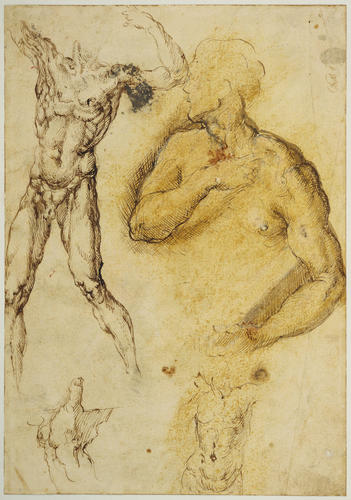-
1 of 253523 objects
The Battle of Hercules and Theseus against the Amazons; verso, figure studies after Michelangelo c.1525-30
Pen and ink with wash and white heightening on paper prepared reddish-brown. Verso, pen and ink with white heightening, partly rubbed over with yellow pastel | 20.2 x 29.0 cm (sheet of paper) | RCIN 905435

Biagio Pupini (active 1511-after 1575)
The Battle of Hercules and Theseus against the Amazons; verso, figure studies after Michelangelo c.1525-30

Biagio Pupini (active 1511-after 1575)
The Battle of Hercules and Theseus against the Amazons; verso, figure studies after Michelangelo c.1525-30


-
On the recto of the sheet, a Battle of Hercules and Theseus against the Amazons, in the manner of a relief or gemstone, though possibly after a lost design by Giulio Romano rather than after the Antique.; On the verso are a series of copies after studies by Michelangelo. The bust-length figure and hand are copied from studies by Michelangelo on a sheet in the Ashmolean (Parker 297): the bust-length is a study for the putto who accompanies the Libyan Sibyl on the Sistine ceiling, and the sketched hand is that of the Sibyl herself, holding a book. Michelangelo’s originals, however, are in red chalk, and Pupini’s copies are therefore of motif, not medium and style.
The other two drawings may copy lost drawings by Michelangelo. Despite its comparative awkwardness of pose and proportions, the full-length figure on the left, who seems to be beckoning, is comparable in type and musculature with the most elaborate of Michelangelo’s red chalk écorchés (anatomical figures with the skin stripped to the muscle), which are generally thought to date from the later 1510s. These were posed in a quasi-narrative manner, whether or not Michelangelo intended to employ them in compositions, and the same is true of the present figure. It is probable that the small half-length torso at lower right is also after a sketch by Michelangelo: there is some relation of form and pose with the putto supporting the throne of the prophet Joel in the Sistine ceiling, but the similarity is not compellingly close.
It remains to be explained how the minor Bololgnese painter and prolific draftsman Pupini knew some of Michelangelo’s drawings. He seems to have passed an early phase in Rome, in some association with the workshop of Raphael, with whose drawings he was also acquainted. Although it is hard to believe that he had direct access to Michelangelo’s studio, he certainly knew other drawings for the Sistine ceiling – a drawing in the Louvre (748v), for example, probably copies a lost sketch by Michelangelo.
In the absence of any chronological understanding of Pupini’s drawings, the date of the present sheet is difficult to determine. But the head of the bust-length copy is treated in a rhythm reminiscent of Parmigianino’s pen style, after the mid 1520s; and Michelangelo’s Ashmolean sheet was known to Primaticcio, who also copied a figure from it – it is therefore likely that it was one of the sheets taken to France by Antonio Mini in 1531. Pupini’s copy therefore probably dates from the late 1520s.
Text adapted from P. Joannides, Michelangelo and his Influence, 1996, no. 30. -
Creator(s)
-
Medium and techniques
Pen and ink with wash and white heightening on paper prepared reddish-brown. Verso, pen and ink with white heightening, partly rubbed over with yellow pastel
Measurements
20.2 x 29.0 cm (sheet of paper)
Other number(s)